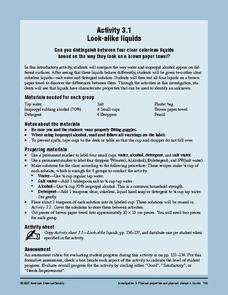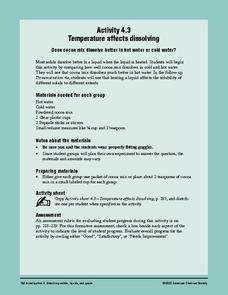American Chemical Society
Solubility Test
Make sure to consult the teacher's handbook, Inquiry in Action - Investigating Matter Through Inquiry, for two demonstrations that can be done to introduce solubility and measuring crystal mass before having the class conduct this...
American Chemical Society
Look-Alike Liquids
Here is the first of four experiments to differentiate among unknown liquids by their behaviors and properties. Pupils observe how different liquids respond to being placed on plastic and paper, and they take notes about their...
American Chemical Society
Temperature Affects the Solubility of Gases
Dare your class to drive dissolved carbon dioxide out of carbonated liquid at different temperatures to discover if there is a difference in rate. To make this experiment more sound, have explorers use equally measured amounts of soda...
American Chemical Society
Dissolving Different Liquids in Water
Not many youngsters realize that solids aren't the only materials that can possibly be dissolved in water. During this investigation, they find out that some liquids can dissolve in water as well. This is part of a unit on solubility,...
American Chemical Society
Temperature Affects Dissolving
Stir chocolate drink mix into hot and cold water to see if there is a difference in how quickly it dissolves. Number three in a six-lesson unit on dissolving, this installment investigates the effect of temperature. If you consult the...
American Chemical Society
Dissolving a Substance in Different Liquids
Second of six lessons in a unit on dissolving, this one focuses on how sugar behaves in different liquids. Learners stir it into water, alcohol, and oil and make observations. This lesson can stand alone, but is best used as part of the...
American Chemical Society
Defining Dissolving
Physical science investigators mix sugar and food coloring into different cups of water and cooking oil to compare how the solid and liquid behave in each. As the introduction to this unit on dissolving, it is relevant.
American Chemical Society
Using the Combining Test to Identify Unknown Liquids
Once investigators have learned how their mystery liquids interact with water during the preceding activity, they now use their observations to identify them. This is an ideal conclusion to the mini unit on the properties of water.
American Chemical Society
Using Color to See How Liquids Combine
Blue-tinted water is added to unknown liquids that have been tinted yellow to find out how they interact. This is a memorable activity that is part of an investigation on the properties of liquids, which is part of a unit on the...
American Chemical Society
Recrystallization Test
Crystallize the answer to the question that has been investigated since the first of four lessons: What is the unknown crystal? Pupils have examined, crushed, and dissolved four samples plus an unknown as an exploration of the properties...
American Chemical Society
Curious Crystals
Crystals are more than meets the eye! Can learners tell them apart simply by observation? As they examine five samples with a magnifier, they find that appearance alone is not enough. This serves as an introduction to a mini unit on...
American Chemical Society
Mysterious M&M's
The first in a six-lesson mini unit, all using M&Ms® candies, this physical science activity gets kids to observe a single piece and discover what happens when it is placed in a plate of water. The activity can be used to introduce...
Scholastic
Study Jams! Elapsed Time
Identify the larger number, place the smaller number on the bottom, and then subtract in order to determine elapsed time. Animated slides of each step are also narrated by a friendly voice to teach elementary math minds how to solve such...
Scholastic
Study Jams! Circle Graph
Over a pizza dinner, RJ and Mia discuss how to use a circle or pie graph to represent data. After viewing, data analysts can use a Test Yourself feature to assess their own understanding. This is ideal for use in a flipped classroom lesson.
Scholastic
Study Jams! Bar Graphs
Mia teaches Sam how to create a bar graph, including forming a title, creating and labeling the axes, choosing a scale, and entering data. After viewing, data analysts can test themselves with seven follow-up questions and review...
Scholastic
Study Jams! Units of Measurement
As Mia and RJ discuss measurement, your class is introduced to the customary and metric systems for measuring mass, capacity, weight, and length. Temperature scales are also introduced. This resource can help set the foundation for later...
Scholastic
Study Jams! Identify Missing or Extra Information
Learn to maneuver through word problems by identifying the specific information needed to solve it. Is there unnecessary information? Is there missing information?
Scholastic
Study Jams! Add & Subtract Measurements
How much leopard print fabric will Zoe need to upholster a sofa for her jam studio? This problem is the example used to teach how to add and subtract measurement-related values.
Scholastic
Study Jams! Perimeter
Follow this engaging slide show on the calculation of polygon perimeter with some hands-on measurement of perimeters to solidify the concepts. On this webpage there are interactive assessment questions and links to related resources by...
Scholastic
Study Jams! Convert Units of Time
How many seconds are in a minute? Or rather, how many seconds are in eight minutes? This problem is worked out through a series of animated steps and explained by a friendly young lady's voice. Your time travelers will appreciate this...
Scholastic
Study Jams! Estimate Whole Numbers
Watch animated slides as RJ explains how to round numbers to the nearest ten and thousand. Viewers then get a chance to try it themselves.
Scholastic
Study Jams! Place Decimal on a Number Line
Through four steps, three different time values for a 100-meter run are arranged on a number line in order to practice ordering decimal numbers. The price of two sports drinks are also compared. All of this comes in narrated and animated...
Scholastic
Study Jams! Addition & Subtraction of Decimals
So current with preteens is the topic of downloading tunes into their computers! In a relatable lesson, viewers are taught to figure out if Zoe can afford to purchase two songs if she has $3.00 left to her credit. Mia talks them through...
Scholastic
Study Jams! Place Value of Decimals
Here is a clear explanation of decimal place value using batting average as the example. Narrated and animated steps are clicked on so that learners can progress at their own pace. Consider having fifth graders interact with this website...














